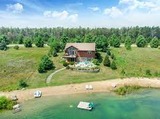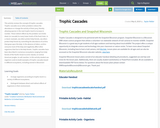
Students interact with simulations to investigate ionic and covalent bonding.
- Subject:
- Chemistry
- Physical Science
- Material Type:
- Homework/Assignment
- Date Added:
- 12/12/2018

Students interact with simulations to investigate ionic and covalent bonding.

Plans for a 5 day collaborative mini unit between Physics/Engineering and Music, exploring how sound interferes within spaces and how acoustic treatments can be used to improve sound.

Biology storyline showcasing human impact on lake ecosystems.

This activity reviews the concept of trophic cascades. Trophic cascades occur when predators reduce the abundance or change the activity of their prey, thereby allowing species in the next trophic level to increase in number. These indirect effects by the predator can trickle down (or cascade) to many lower levels of the food chain. In a classic example, sea otters protect kelp forests, sea otters protect kelp forests by controlling the abundance of urchins that graze upon the kelp. In the absence of otters, urchins consume most of the kelp and negatively affect other organisms that live in the kelp forests.
Trophic cascades have been described in numerous ecosystems ranging from kelp forests of the Pacific Ocean to arctic islands, to Central American jungles, to salt marshes. In this activity student use organism cards to build examples of trophic cascades based in different ecosystems, including several in Wisconsin!

This is a publicly accessible website that contains wonderful, Wisconsin based data. Maybe the writing from another Wisconsin HS science teacher provides some ideas for how these data could be used.